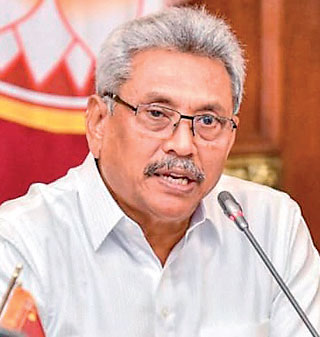Friday Feb 07, 2025
Friday Feb 07, 2025
Monday, 27 December 2021 00:00 - - {{hitsCtrl.values.hits}}

President Gotabaya Rajapaksa

Prime Minister Mahinda Rajapaksa

Finance Minister Basil Rajapaksa
Has the time come to seriously consider the merits of restructuring the Government’s external debt obligations? The Sri Lankan authorities have indicated that they are in the process of negotiating inflows to meet the country’s immediate foreign exchange requirements. However, there is considerable uncertainty as to whether there would be sufficient inflows to meet the acute dollar illiquidity over the medium-term.
Companies and even families restructure their debt when foreseeable future earnings become insufficient to repay debts while maintaining their financial viability. The same applies to countries. Over the years, a number of countries have restructured their debt and the pandemic is pushing others to follow suit. Has Sri Lanka reached that point when it would be advantageous to restructure its external debt? What are the costs and benefits of doing so? If debt restructuring is a credible option, how would one go about it?
Should Sri Lanka restructure its external debt?
Foreign revenues in the next couple of years are extremely unlikely to be sufficient to service external debt obligations, while supporting the essential foreign exchange (Forex) requirements of the economy. Known external debt repayments amount to $ 26 billion over the next five years. It is unrealistic to expect to repay about $ 5 billion per year, particularly in the next 12-24 months, when foreign inflows are unlikely to increase on the scale necessary to service debt and finance imports necessary to meet essential needs and support the growth of the economy, particularly as the downgrading of Sri Lanka’s sovereign rating has excluded it from international capital markets. Countries protect access to these markets scrupulously to have the capacity to roll-over debt and avoid such a predicament.
It is noteworthy that the following business chambers have jointly issued a statement highlighting the severe problems being faced by their members due to the acute shortage of Forex which has been caused primarily by the combination of the loss of tourism earnings and access to international capital markets: Ceylon Chamber of Commerce, FCCISL, Ceylon National Chamber of Industries, The National Chamber of Commerce of Sri Lanka, The Women’s Chamber of Industry and Commerce, Chamber of Young Lankan Entrepreneurs, The International Chamber of Commerce Sri Lanka, National Chamber of Exporters and the Chamber of the Construction Industry.
Collectively, these Chambers represent almost all sectors of the economy. Their concerns cannot be addressed while there is a diversion of large amounts of Forex from markets to the Central Bank of Sri Lanka (CBSL) to service external debt. As a result, there is now a strong case for considering debt restructuring to release foreign exchange to meet the needs of businesses and acquire the essential needs of the people, e.g., food, fuel and pharmaceuticals.
The costs and benefits of external debt restructuring
The most significant disadvantage of restructuring external debt is an immediate loss of access to international capital markets. This is now completely irrelevant for Sri Lanka as market access was lost when the economy was downgraded to a CCC rating. It is now even lower, at CC. As a result, Sri Lanka can no longer borrow in international markets. Another downside is the increase in the risk premium Sri Lanka would need to pay when it is eventually able to regain market access.
However, the increased risk premium demanded by markets as a result of the restructuring is likely to be tempered by the impressive commitment Sri Lanka has shown in meeting its obligations thus far. Two International Sovereign Bonds (ISBs) of $ 1 billion each were repaid on time in October 2019 and July 2020, despite having to deplete external reserves, thereby imposing sacrifices on domestic businesses and households. This combined with Sri Lanka’s impeccable debt servicing record to date is likely to contain the increase in the cost of future borrowing when it becomes possible.
Domestic banks have holdings of both ISBs and Sri Lanka Development Bonds (SLDBs). Both these instruments will be impacted by any debt restructuring exercise. Foreign bond holders are extremely unlikely to accept exemption from haircuts of domestic entities, mainly banks, which hold US-denominated debt, issued both abroad and domestically. Hence not only ISBs but also SLDBs will need to be included in the pool of debt to be restructured.
It is important to note that the impact of any haircut will not be as painful as some may fear, since many of the domestic entities have purchased ISBs at an already discounted price in the secondary market. (There would be no such mitigation for SLDBS, which are not a tradable instrument.) If necessary, the CBSL would need to provide some temporary regulatory forbearance to any domestic bank which experiences capital adequacy challenges due to haircuts imposed on creditors as part of the debt restructuring.
Options for restructuring
Debt restructuring is a long and complex process. Having delayed and allowed usable reserves to deplete to barely one month’s import cover, it is no longer possible to achieve a soft pre-emptive restructuring. There are three modalities available to restructure debt: re-profiling the principal (extending maturities); modifying coupon (interest) rates; and write-down of principal (haircuts). Given its current circumstances it is unlikely that Sri Lanka could avoid haircuts for its creditors.
It is unrealistic and impractical to expect to restructure external debt without the support of the IMF. Before embarking on an external debt restructuring, one needs the IMF to independently validate that Sri Lanka has a strong need to restructure its debt, in order to assure creditors that the Sri Lankan authorities are not being opportunistic. The IMF would also need to validate the proposed medium term fiscal adjustment path to debt sustainability.
Rescheduling bilateral, commercial and multilateral debt requires different treatments. Bilateral debt rescheduling is negotiated with the Paris Club of creditors. It is not possible to approach the Paris Club without IMF support. China and India are not members of the Paris Club and separate negotiations would be necessary with them. An option is to seek to initiate an informal ‘Common Framework’ approach (approved by the G20 which includes both China and India). It would need to be informal as the ‘Common Framework’ is not available for a middle income country like Sri Lanka.
This approach would have the advantage of including Sri Lanka’s three major bilateral donors: China, India and Japan. Bilaterals are likely to focus more on stretching maturities. Commercial creditors could be approached once a deal is in place with bilateral donors. Such sequencing can lead to a better deal for the debtor country on the basis of equivalence across all creditors in terms of the rescheduling. In this respect, there is considerable merit in taking soundings from the Japanese Ministry of Finance regarding their suggestions for the terms of the restructuring. Over the years, Japan has proved to be a flexible and generous creditor in this respect.
On commercial debt, here again, it is exceedingly difficult to proceed without the IMF. Given its current circumstances, the restructuring package for Sri Lanka’s commercial debt is likely to include a combination of stretching maturities; coupon modification and a haircut. Haircuts on repayment of principal should be avoided, if at all possible, as they delay rating improvement and regaining market access. It is likely that it is now too late for Sri Lanka to avoid a haircut for its commercial creditors. It makes little sense to scar the economy and cause hardship to the people in order to pay ISB holders 100 cents in the dollar when most of the bonds outstanding have been discounted by more than 40 per cent.
It is not possible to restructure Multilateral debt (i.e., debt owed to the World Bank, the Asian Development Bank and the IMF) without a complete suspension of the relationship between Sri Lanka and these institutions. There would be a suspension of all lending activity including project loans. However, the practice has been for these institutions to provide financing to assist the debtor country to service the payments owed to each of them, once the debt rescheduling package is negotiated.
Appointment of advisers
It is customary to appoint a financial and a legal adviser at the outset of the restructuring process. The IMF is able to provide a list of potential advisers from which the country concerned can choose.
Pathfinder perspective – conclusion
The unsustainability of Sri Lanka’s external debt is the cumulative effect of poor economic management over several decades. The size and persistence of the external financing gap for the foreseeable future makes debt restructuring an urgent priority. It should be possible to negotiate a package which provides three years of breathing space to rebuild Sri Lanka’s economy to earn and attract sufficient foreign inflows to achieve external debt sustainability and place the economy on a path of sustained growth.
Nearly 75% of Government external debt is owed to bilateral and commercial creditors, all of which is eligible for rescheduling, thus providing considerable scope for relief from onerous debt repayments. Now that Sri Lanka has lost access to international capital markets and is extremely unlikely to regain it for some years due to its CC rating, there is very little downside and very considerable upside to debt restructuring.
There is now no choice but to restructure our external debt. The positive impact on dollar liquidity will be substantial and could be measured in billions of dollars. It is also timely as the negative social consequences are manifesting themselves in terms of ever-increasing hardships for the people, particularly the poor and vulnerable. It does not seem realistic to count on short term liquidity injections or a reliance on a revival in tourism as well as increased exports, FDI and remittances, to overcome the dollar illiquidity and its negative consequences in the next couple of years. Paying back debt at the expense of scarring the economy and imposing hardships on the people should not be seen as a badge of honour.
(This is A Pathfinder Perspective issued by the Pathfinder Foundation and can be viewed on https://pathfinderfoundation.org/. Readers’ comments via email to [email protected] are welcome.)